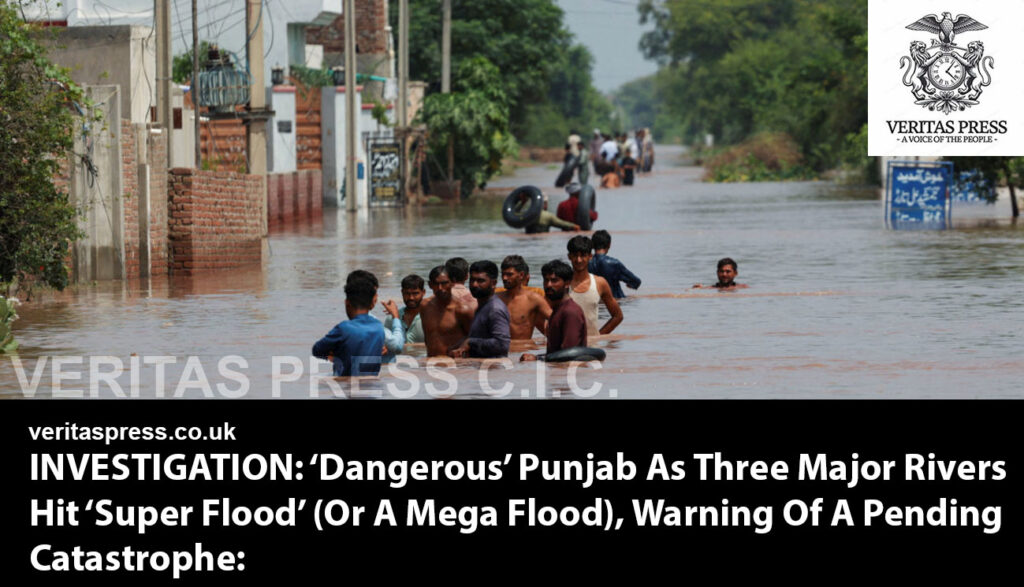Press Release: Veritas Press C.I.C. Author: Kamran Faqir Article Date Published: 03 Sept 2025 at 15:17 GMT Category: Asia | Pakistan | Warning Of A Super Flood Source(s): Veritas Press C.I.C. | Multi News Agencies

LAHORE — Pakistan’s Punjab province is facing a historic emergency. For the first time, the Sutlej, Ravi and Chenab are simultaneously in “super flood.” Millions have already been displaced, crops destroyed, and livestock drowned. But scientists, disaster managers and activists warn: unless urgent defensive measures are implemented, the water surges building in Punjab will cascade downstream into Sindh, triggering a pending “super flood” event that could rival, or even surpass, Pakistan’s past mega-disasters.
“We are standing on the edge of another catastrophe. If embankments are not reinforced and evacuations not enforced now, the coming surge could be uncontainable.” — Masood Lohar, climate and disaster management expert.
The Crisis Today:
Punjab PDMA Director-General Irfan Ali Kathia described the situation as “unprecedented.” Flows in the Sutlej are the highest since 1955, while the Ravi has not carried such volumes since 1988. “Never before in Pakistan’s history have three rivers been in super flood together,” he said.
Provincial minister Maryam Aurangzeb told reporters that more than 2 million people have been affected. Entire villages in Muzaffargarh, Kasur and Narowal are underwater. “This is the biggest flood in Punjab’s history,” she said.
At least 30 people have died in Punjab in the past week, with the nationwide toll since June climbing above 849, according to the NDMA.
The Warning Signs Ahead:
The Flood Forecasting Division (FFD) projects that:
- The Chenab at Trimmu and Ravi at Balloki will maintain dangerous levels,
- The Panjnad barrage will face very high flood by September 3,
- The Indus at Guddu may cross the 900,000 cusecs “super flood” threshold by September 5.
Sindh Chief Minister Murad Ali Shah has publicly admitted that his province’s defences could buckle if such flows materialise:
“We call it a super flood when the water level exceeds 900,000 cusecs. We hope it will not reach that point, but we have to be prepared. Human lives and livestock are at stake.”
Meteorologists add that further rains in the upper Sutlej, Beas and Ravi catchmentsonSept. 2–3 could intensify the deluge.
Echoes Of 2010 And 2022:
The unfolding disaster has revived painful memories of Pakistan’s past floods:
- 2010 Indus floods: Triggered by monsoon rains and river surges, the Indus inundated one-fifth of the country. Over 20 million people were affected, 2,000 killed, and $10 billion in damages recorded. International observers called it one of the worst humanitarian crises of the decade.
- 2022 “super floods”: Caused by record monsoon rainfall and glacial melt, the floods killed over 1,700 people, displaced 33 million, and caused $30 billion in economic losses. Entire swathes of Sindh and Balochistan remained under water for months.
Analysts say the same systemic failures are repeating now.
“We promised after 2010, and again after 2022, that ‘never again.’ Yet embankments remain weak, floodplains remain occupied, and evacuation planning is reactive rather than preventive,” — Farzana Bari, Islamabad-based social analyst.
In Punjab today, families describe evacuating at night, without prior warning.
“We woke up to water entering our house. Nobody came to tell us earlier. We just grabbed the children and ran,” — Shahnaz Bibi, resident of Narowal district.
Climate Crisis Multiplier:
A new World Weather Attributionstudy confirms that climate change has made Pakistan’s monsoon far deadlier. Average 30-day rainfall intensity has increased by ~22%, turning what would once be “rare” disasters intoonce-in-5-year events.
“The floods we are witnessing are not accidents, they are engineered by global warming. Every tenth of a degree of warming increases the risk,” — Mariam Zachariah, climate scientist, Imperial College London
Yet Pakistan’s adaptation has not kept pace. Instead of investing in resilient flood management, experts say successive governments have funnelled resources into urban megaprojects and debt servicing.
India’s Upstream Releases:
The crisis has also been exacerbated by water releases from upstream India. Though India provided formal notifications, Pakistani officials argue the alerts were too late for villagers to evacuate. The Foreign Ministry has ordered an inquiry into whether the discharges were “deliberate.”
“These sudden surges are not just nature. They are political. We need cross-border river data sharing in real time, not after the water is already here,” — Ahmed Rafay Alam, environmental lawyer and activist
“A Pending Super Flood”:
Experts warn that what Punjab is seeing may only be the beginning. If inflows continue and barrages downstream are overwhelmed, Sindh could face catastrophic inundation within days.
Already, authorities are considering controlled breaches of embankments to save major cities at the expense of rural land. Farmers say this would mean the destruction of their standing crops and livelihoods.
“We are sacrificing our villages so that Multan and Bahawalpur survive. But who will feed our families if our crops are washed away?” — Noor Mohammad, farmer in Sher Shah
What Must Be Done, Now:
Disaster experts and activists stress that the next 72–96 hours are critical:
- Reinforce embankments at Guddu, Sukkur, Trimmu and Panjnad with emergency military engineering units.
- Expand early warning systems with door-to-door evacuations in high-risk districts.
- Pre-position food and medicine in camps to avoid outbreaks of cholera and malaria.
- Begin silt dredging and embankment repair plans immediately after floodwaters recede.
- Revive Indus Basin Treaty mechanisms for real-time water flow sharing with India.
Conclusion: A Nation At The Edge Of A Mega Flood (Super Flood).
The swollen Sutlej, Ravi, and Chenab are not just rivers in flood, they are warning signs of a country spiralling toward a “Mega Flood Event” that could upend its very foundations. Record monsoon rains have collided with decades of mismanagement, reckless residential and industrial development in floodplains, and weak flood defences, creating a humanitarian and economic crisis of historic proportions.
The devastation is already staggering: fertile farmland drowned, crops destroyed, livestock lost, and entire harvests wiped out in Punjab’s breadbasket, threatening Pakistan’s food security just months before winter sowing. Farmers, who form the backbone of the economy, are left stranded, their fields transformed into inland seas. The displacement is not temporary; it is becoming structural. Villages are depopulating, families abandoning ancestral lands, and communities that once fed the nation are now trapped in cycles of debt, ruin, and migration.
Yet the state’s response has been appalling. The lack of preventative measures, from embankment reinforcement to zoning enforcement and channel clearing, is compounded by the inadequate relief for victims: overcrowded camps, insufficient food and medicine, and children sleeping without shelter while politicians’ stage symbolic visits.
“We are not sitting here by choice. Our houses are under water, our animals are starving, and no one from the government is helping us,” – said Emaan Fatima, a resident displaced to a Multan relief camp.
At the heart of this systemic failure are Pakistan’s own institutions:
- The National Disaster Management Authority (NDMA) has again focused on tallying casualties rather than preventing them.
- The Provincial Disaster Management Authority (PDMA) failed to enforce timely evacuations or prepare durable shelters.
- The Ministry of Water Resources continues to manage rivers with outdated data and politics-driven water releases instead of climate-adaptive science.
- Local irrigation departments have allowed illegal encroachments along canals and floodplains, magnifying destruction.
These domestic failures echo past disasters. In 2010, the Indus floods displaced over 20 million people. In 2022, record monsoon rains killed over 1,700 and caused $30 billion in damages. After each crisis, the government promised reforms, embankments, early warning systems, and disaster preparedness, yet the same institutional failures are being repeated in 2025, only now with three rivers converging at unprecedented “super flood” levels.
More than two million people are already at risk, and downstream Sindh faces the prospect of a pending “super flood” – or even a “mega flood” if Guddu and Sukkur barrages are breached.
“We are witnessing the slow-motion collapse of Pakistan’s river management,” said Dr. Muhammad Ajmal Shad, hydrologist at Punjab University. “If the state does not act now, the mega flood will not only kill people, it will permanently depopulate entire regions.”
The crisis is compounded by international structural pressures. Pakistan’s response capacity is constrained by IMF-imposed austerity, high debt repayments, and chronic underinvestment in infrastructure, leaving flood defences chronically underfunded. Climate scientists warn that Pakistan, as one of the country’s most vulnerable to climate change, is facing a crisis exacerbated by global inaction on climate mitigation and reparations.
“Pakistan’s floods are not only a domestic governance failure, they are the product of a global system that externalises climate costs onto the poorest countries,” said – Mariam Zachariah, Imperial College London.
The Truth Is Inescapable: Pakistan’s floods have evolved into political and systemic failures due to corruption, not just natural ones. Without urgent action, reinforced embankments, the construction of dams, improved river management, evacuation and shelter for millions, and international support for climate adaptation, the “mega flood” currently building will become a catastrophic reality.
The water is rising, farmland is disappearing, villages are emptying, and millions are fleeing. 2010 was a warning. 2022 was a second warning. 2025 may be the breaking point. Pakistan has been warned before, but unless domestic institutions act decisively and the international community supports climate adaptation, the coming deluge could redraw the country’s map and permanently displace millions.
Tags:



Leave a Reply